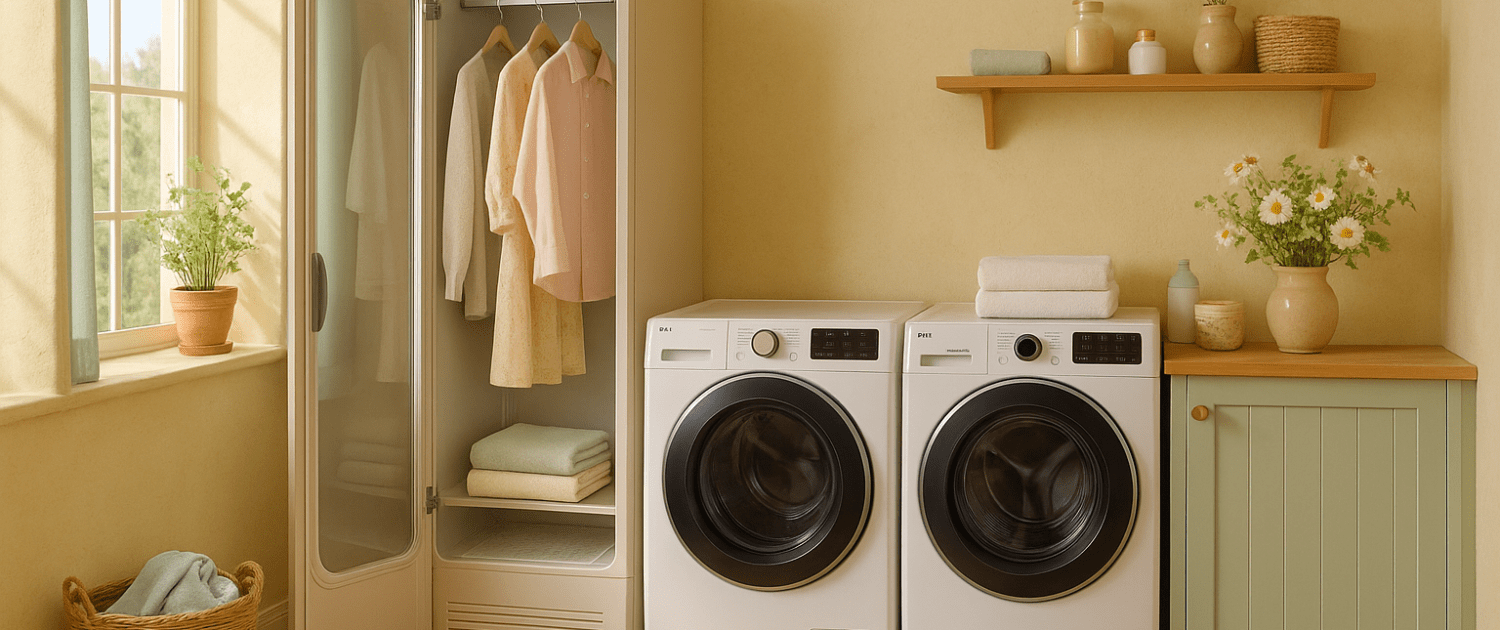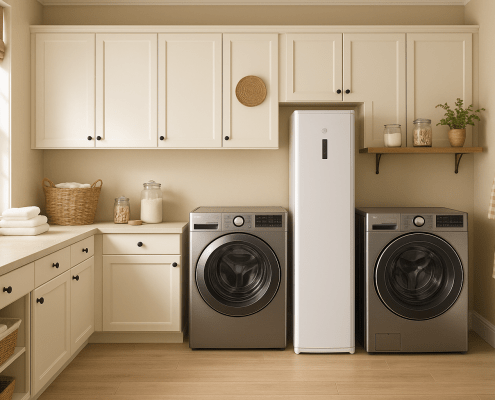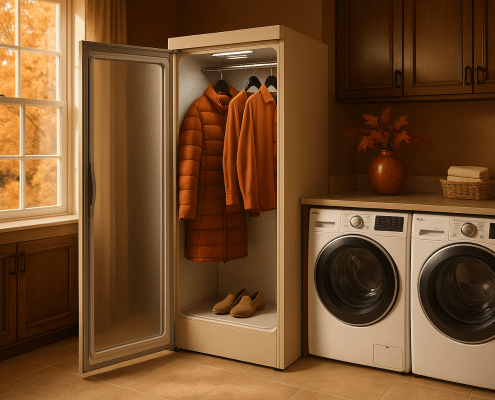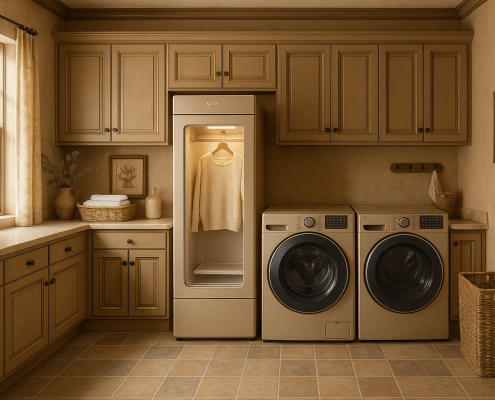What to Know About Laundry Steam Closets and How They Work
Steven E / Monday July 14, 2025
You’ve probably seen them in showrooms or online and thought, “Wow, that’s fancy!” But what exactly is a laundry steam closet—and how does it work? Simply put, it’s a sleek appliance that uses gentle heat and steam to refresh, sanitize, and de-wrinkle your clothes without a full wash. Here’s everything you need to know about laundry steam closets and how they can level up your laundry game.
What Is a Laundry Steam Closet?
A laundry steam closet is a freestanding appliance that looks similar to a tall, narrow wardrobe. Inside, it features a hanging space, shelves, and sometimes specialized racks. Instead of washing and drying your clothes, the steam closet uses heat and steam to remove wrinkles, refresh fabrics, and eliminate odors.
Think of it as your own personal valet. With just a few presses of a button, you can take clothing that’s been sitting in a closet or worn for a day, and make it look and feel as though it just came back from the cleaners, without the hassle or expense.
The steam closet doesn’t replace your washing machine. You’ll still need to launder clothes that are visibly dirty or stained. But for garments that just need a refresh, it’s a perfect solution.
How Does a Laundry Steam Closet Work?
The magic of a steam closet comes down to a few key parts working together including:
- Water Reservoir: At the heart of the steam system is the water reservoir. This tank holds clean water that the machine heats into steam. Many steam closets recommend or require using distilled water to prevent mineral buildup.
- Steam Generator: The steam generator heats the water and produces a steady flow of vapor. This steam is then released into the chamber, raising humidity and relaxing fabric fibers.
- Heating Elements: Heating parts maintain the proper temperature to create steam and to lightly dry clothing at the end of the cycle. These parts are designed to keep the inside of the closet warm enough for effective de-wrinkling without damaging fabrics.
- Air Circulation System: A fan or air circulation system ensures the steam and heat distribute evenly throughout the chamber. It also helps expel excess moisture and bring in fresh air during drying and deodorizing phases.
- Humidity and Temperature Sensors: Sensors monitor the humidity and temperature levels inside the chamber to keep conditions optimal for the selected cycle. If you ever get error codes or poor performance, testing these parts is a good place to start.
- Door Gasket: A flexible gasket seals the door shut to prevent steam leaks. Over time, this part can wear out and may need to be replaced if you notice steam escaping during a cycle.
- Hangers and Racks: The interior is equipped with hangers, a clothes rack, and sometimes specialized racks for pants or accessories. These are designed to hold clothing in just the right position for optimal steaming.
When you close the door, choose your cycle, and press start, the closet quickly heats up and fills with steam. After the steaming phase, the closet switches to a drying phase to remove any remaining moisture. When it’s done, your clothes are fresh, wrinkle-free, and ready to wear.
Benefits of a Laundry Steam Closet
So why are steam closets gaining popularity? There are several reasons homeowners love them.
- Removes Wrinkles Without Ironing: If you hate ironing (and who doesn’t?), you’ll love how a steam closet makes your clothes look pressed and polished without a single pass of an iron.
- Refreshes Without Washing: Not every garment needs to go through a full wash cycle. For items you’ve only worn once or that just feel stale, the steam closet is a fast and water-efficient alternative.
- Eliminates Odors: Steam is great at removing smells from smoke, food, or sweat.
- Sanitizes Fabrics: Many steam closets are effective at killing bacteria and reducing allergens, which is a bonus if you have sensitive skin or allergies.
- Gentle on Delicates: The gentle steam process is much safer on delicate fabrics than traditional washing and drying.
- Saves Time and Money: You’ll spend less on trips to the dry cleaner, and you can freshen up clothes in a fraction of the time it takes to wash and dry them.
How to Use a Steam Closet
One of the great things about a steam closet is how easy it is to use. Here’s how a typical cycle works.
- Fill the Water Reservoir: Steam closets need water to generate steam. Make sure the water reservoir is full before starting a cycle. Some models have removable tanks that you can fill at the sink.
- Load Your Clothes: Hang your garments on the provided hangers or place them on the racks. Leave some space between items so steam can circulate freely. Avoid overloading the closet.
- Choose Your Cycle: Most steam closets offer several cycles for different fabric types and needs. Choose the cycle that best matches what you’re treating.
- Start and Wait: Close the door securely and press start. The closet will begin steaming and drying. Most cycles take between 20 and 45 minutes.
- Remove Clothes: When the cycle finishes, open the door and remove your clothes. They’ll be ready to wear immediately.
Common Questions About Steam Closets
Can I use it on all fabrics?
Most everyday fabrics like cotton, wool, polyester, and blends respond well to steam. However, some delicate fabrics like silk or heavily embellished garments may need a gentler cycle or may not be suitable. Always check the care label.
Do I still need to wash my clothes?
Yes. A steam closet refreshes and sanitizes clothes, but it does not replace washing when garments are dirty or stained.
How much water does it use?
Steam closets are very water efficient. A full tank is usually enough for several cycles, and they use far less water than a washing machine.
Does it use a lot of electricity?
Steam closets are designed to be energy efficient. They use less power than running a full washer and dryer cycle.
Where To Find Us
If you need any replacement parts for your appliances, you can enter your model number at AppliancePartsPros.com to locate and order them quickly. Most orders arrive in just two business days, and we have tons of great information in our repair help section and YouTube videos to help you troubleshoot.
Stay connected with the latest DIY tips, tutorial videos, and repair guides by following us on Facebook, Instagram, and Twitter. We love hearing about your repair stories and successes. If you need more help or want personalized guidance, feel free to reach out. We’re ready to help you take on your next project with confidence!
The information in this article may not apply to your specific appliance model. We recommend consulting your manufacturer’s documentation or contact us with any questions.
With nearly a decade of experience in providing top-notch customer service regarding appliance parts and repair, Steven enjoys sharing practical advice, troubleshooting tips, and interesting information to help readers stay informed.





